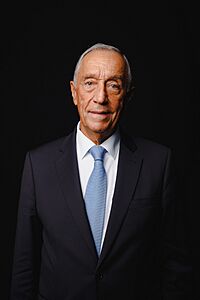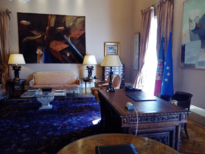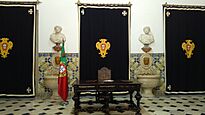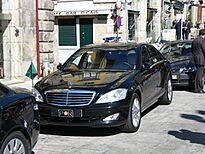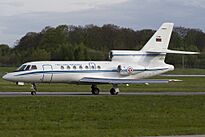President of Portugal facts for kids
Quick facts for kids President of the Portuguese Republic |
|
|---|---|

Presidential standard
|
|

Coat of arms used by the presidency
|
|
| Presidential Office of the Portuguese Republic | |
| Style |
|
| Member of |
|
| Residence | Belém Palace |
| Seat | Lisbon, Portugal |
| Appointer | Direct election |
| Term length | Five years
renewable once consecutively
|
| Constituting instrument | Constitution of Portugal (1976) |
| Precursor | Monarch of Portugal and the Algarves |
| Formation | 24 August 1911 |
| First holder | Manuel de Arriaga |
| Succession | Speaker, then one of its deputies per seniority |
| Salary | €137,662 annually |
The President of Portugal is the country's head of state. This means they are the top leader and representative of Portugal. The official name for this role is the President of the Portuguese Republic.
Portugal has a special government system called a semi-presidential system. This means the president has some important powers, but they don't directly run the government day-to-day. That job belongs to the prime minister and the parliament. The president acts more like a "moderator," making sure everything works smoothly between the different parts of the government.
The current President of Portugal is Marcelo Rebelo de Sousa. He started his job on March 9, 2016.
Contents
What the President Does
Portugal's government is a semi-presidential system. Even though the president is often seen as a symbolic figure, they have more power than many other presidents in Europe.
The prime minister and parliament handle most of Portugal's daily government work. However, the president has a lot of influence, especially in areas like national safety and how Portugal deals with other countries. The president is also the top commander of the Armed Forces. This means they are the highest-ranking official in the country.
Before 1974, the president's powers changed a lot. Some presidents were very powerful, almost like dictators. Others had very little real power. During a time called the Estado Novo, the president was supposed to have a lot of power. But in reality, the prime minister held the most control.
Choosing the Prime Minister
One of the president's biggest powers is choosing the prime minister. However, the parliament has the power to remove the prime minister. So, the president must pick someone who most members of parliament trust. If not, the prime minister could quickly face a vote to remove them.
The president can also decide to dissolve parliament. This is sometimes called the "atomic bomb" power in Portugal. It means new elections must be held. For example, President Jorge Sampaio used this power in 2004. He removed the government of Pedro Santana Lopes, even though many members of parliament supported it.
Leading the Armed Forces
The president is the supreme commander of the armed forces. In 2003, President Sampaio used this power to limit Portugal's involvement in the Iraq War. He did not allow the Portuguese Army to be sent to a war he disagreed with. This caused a disagreement with the prime minister at the time, José Manuel Barroso. Because of this, the government sent members of the National Republican Guard (GNR) instead. The GNR is a military force, but it is not part of the regular Armed Forces.
President's Powers
The Portuguese constitution gives the president several important powers:
- The president is the top commander of the Armed Forces. They also lead all Portuguese national honors and awards. They choose the top military leaders, based on suggestions from the government.
- The president can dissolve the parliament. If this happens, new elections must be called, and the government must resign.
- The president appoints the prime minister, usually after looking at election results. They also appoint other government members suggested by the prime minister. The president can also remove the government if it's needed for the country's democratic system to work well.
- The president can dissolve the governments of Portugal's special regions if they do things that go against the constitution.
- The president can declare a state of siege or emergency. This happens after talking with the government and getting permission from parliament.
- The president can declare war or make peace. This is done after the government suggests it and parliament gives permission.
- The president signs laws, decrees, and other government decisions. They can also veto them, meaning they refuse to sign them.
- In international matters, the president approves international agreements and treaties.
- The president decides if a public vote (referendum) should happen, if parliament suggests it.
- The president can ask the Constitutional Court to check if new laws or agreements follow the constitution.
- The president appoints many important state officials. These include representatives for the special regions, the head of the Court of Auditors, and the Attorney General. They also appoint some members of the Council of State and the Superior Council of the Judiciary.
- The president appoints ambassadors to other countries and welcomes foreign ambassadors to Portugal.
- The president can grant pardons or reduce sentences for people who have been convicted of crimes, after talking with the government.
How the President is Chosen
The president is elected for a five-year term. To be a candidate, a person must be of Portuguese origin and at least 35 years old. A president can be reelected any number of times, but only twice in a row. The official home of the Portuguese president is the Belém Palace in Lisbon.
The election uses a two-round system. If no candidate gets more than 50% of the votes in the first round, the top two candidates have a second election two weeks later. This second round has only been needed once, in the 1986 election.
Since 1974, all elected presidents have served two terms in a row. Presidents are usually very popular in Portugal. However, former president Aníbal Cavaco Silva became less popular during his time in office. By 2024, Marcelo Rebelo de Sousa also had lower popularity ratings.
What Happens if the President Can't Serve?
If the president dies or becomes unable to do their job, the president of the Assembly takes over. They have limited powers until a new president can be elected.
President's Home
The Belém Palace has been the official home of the President of Portugal since 1910. It was built in the 16th century by a diplomat named Manuel de Portugal. Later, King John V bought it in the 18th century. It was one of the homes for the Royal Family until the early 1900s.
Marcelo Rebelo de Sousa, the current President, lives in the palace.
Last Election
2021 Presidential Election
| Candidates | Supporting parties | First round | ||
|---|---|---|---|---|
| Votes | % | |||
| Marcelo Rebelo de Sousa | Social Democratic Party, People's Party | 2,531,692 | 60.66 | |
| Ana Gomes | Independent supported by People–Animals–Nature, LIVRE | 540,823 | 12.96 | |
| André Ventura | CHEGA | 497,746 | 11.93 | |
| João Ferreira | Portuguese Communist Party, Ecologist Party "The Greens" | 179,764 | 4.31 | |
| Marisa Matias | Left Bloc, Socialist Alternative Movement | 165,127 | 3.96 | |
| Tiago Mayan Gonçalves | Liberal Initiative | 134,991 | 3.23 | |
| Vitorino Silva | React, Include, Recycle | 123,031 | 2.95 | |
| Total valid | 4,173,174 | 100.00 | ||
| Blank ballots | 47,164 | 1.11 | ||
| Invalid ballots | 38,018 | 0.89 | ||
| Total | 4,258,356 | |||
| Registered voters/turnout | 10,847,434 | 39.26 | ||
| Source: Comissão Nacional de Eleições | ||||
Travel
Timeline of Presidents (since 1910)

See also
 In Spanish: Presidente de Portugal para niños
In Spanish: Presidente de Portugal para niños
- Politics of Portugal


